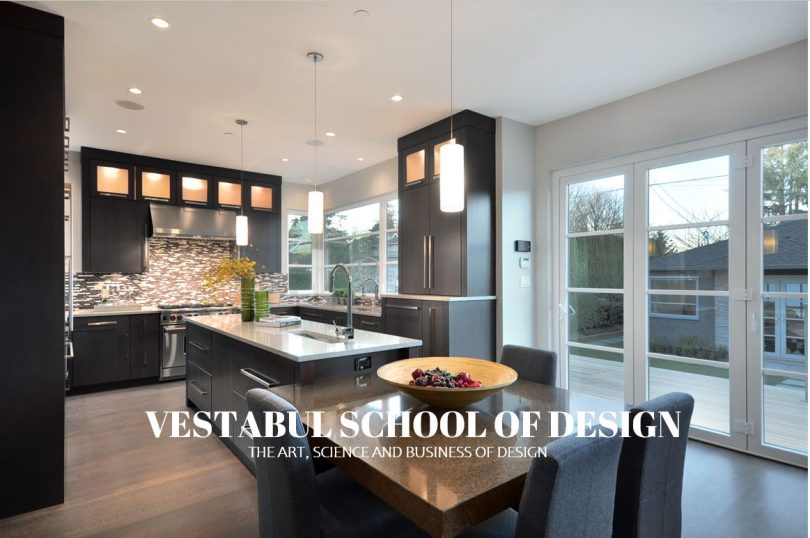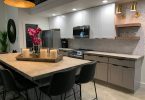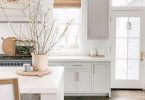Recently, we had the opportunity to interview Jan Rutgers, an interior designer with over 25 years of experience and the current president of Vestabul School of Design. During our conversation, Jan shared her insights on the industry, discussed her work at Vestabul School of Design, and provided valuable advice for aspiring designers. We hope you enjoy reading this interview as much as we enjoyed conducting it!

Hi Jan, thank you so much for taking the time out of your day to chat! You have a rich experience under your belt. Can you tell us how did you start working in the industry?
While at University, I took an extra class one summer session on Kitchen Design. It convinced me to look at home design rather than fashion design as a career direction. It provided me with a “portfolio” and I was able to land a job at a manufacturer’s showroom soon after graduation. Since then I have held many positions in the kitchen industry including design sales manager, independent designer, owner of a to-the-trade showroom, owner of a custom cabinet/millwork shop, corporate product director, corporate design director, and now educator.
Can you elaborate on the pros and cons of each position? Recommendation for a new designer, where to start?
Most new designers should start at an established kitchen design firm or showroom to get some experience. As I said, my first position in the industry was as a designer at a cabinet manufacturer’s showroom. While there I gained the experience to become the sales manager to lead the design team. Part of this experience included taking a variety of sales and management courses to take on the role.
If the new designer’s training was in both design and business they could venture out on their own and establish an independent kitchen design business. However, I would still recommend they partner with an experienced cabinet supplier to ensure none of the complicated details of kitchen design is missed.
Most of the positions that I have held in the design industry evolved from a need. I launched my independent design career because I wanted more flexibility in design. When working for a manufacturer the goal is to design with and sell their products. As an independent, you have more flexibility in product selection. After a few years as an independent designer, I became frustrated with not being able to find manufacturers to build my designs. Establishing a custom millwork shop evolved out of the need for more custom options for my clients. My model for custom design and manufacturing soon became something other design professionals were asking me about. This led to opening a to-the-trade showroom where I could work directly with the allied professionals. I understood their needs and had the backup of manufacturing to be able to accommodate them. It would be hard for a new designer to jump immediately into the role of manufacturer or to-the-trade expert but it could be a goal to work towards.
My venture into the corporate world also stemmed from a “need”. Both my product design and development positions were new to the firms I worked for. The positions were developed as part of each firm’s branding initiatives. More and more manufacturers are hiring design directors so it could be a career path for a new designer. In most cases, they would need to gain knowledge as a product manager to move into this role.
I don’t categorize my different positions in the design industry under Pros and Cons. I look at each one of them as a learning experience and have bundled all of that together to become an educator. Again a new designer could go into education right out of school but they will go farther in that career if they have real live design experience to share with their students.
Why did you start your own platform (Vestabul School of Design) and how did you come up with the idea?
Throughout my career, I have always lectured, presented, taught, and written on topics related to design. The idea to develop a platform online began to percolate about 6 or 7 years ago because I had accumulated a lot of content over my 25+ years in the industry.
I experimented with blogging for a year back in 2016 and taught myself the WordPress platform and blogging in general. When the pandemic hit in early 2020 I decided to take this time to focus on building an online platform to teach, coach, and mentor people passionate about the kitchen design industry.

Who are your biggest influences in the industry?
Ellen Cheevers was definitely someone that inspired and influenced me. Ellen was one of my first kitchen design instructors in the late 80s and our paths crossed several times over the years. When I was the design director for a large molding and millwork manufacturer, Ellen and I teamed up in 2015 to develop a CEU which rekindled our friendship. I spent time with her in her own home talking about design, the industry, and the need for education for designers.
Do you think of the Facebook group “2020 Design Power Users Group” as of competition?
No. There is a need in the industry for many types of design training and I encourage it. When I was president of my local NKBA chapter I was asked a similar question. My answer to the kitchen designers was
“We are not each other’s competition. Our competition are other industries such as travel agencies and boat sales firms that are vying for consumers’ disposable income. The more we work together to promote what we do the better.”
What are your thoughts on KBIS? Have you participated as a vendor or attendee?
I feel KBIS is an important part of the kitchen and bath industry. It provides the opportunity for networking, seeing new products, understanding trends, and education. Returning from KBIS always motivates me to push the boundaries of my designs. I attend the show every 2 or 3 years.

I have participated in KBIS as a vendor when I worked in the corporate world and as an attendee several times. I have also presented at KBIS in NKBA”s Voices from the Industry conference. I presented a CEU session at KBIS 2022 that made the highlights page in KBB’s “What’s in store for KBIS 2022”. That session was called “Embracing the New Role of the Kitchen Designer”.
By the way, your website is beautiful! Who is designing it, you or a hire?
I designed the website and built it out myself. I brought on a consultant to help me integrate my WordPress site with my Thinkific Course site. I have added HubSpot to my tech stack and am in the process of trying to navigate it. I have brought on an agency to assist with some of that. There are a lot of dots to connect when working online but I’m pushing through!
You have over 25 years of experience in the industry. What is your best advice for someone just starting out as a designer?
My best advice is to get functional training and practice it. There is a lot of competition in the kitchen industry with many people “designing” kitchens and selling cabinetry based just on the aesthetic look of the room. Top Kitchen designers excel at both the art and the science of design.
Where should our readers look for a kitchen/interior designer?
I think referral is the best place to find a kitchen professional. If you are searching online I would visit the designer’s website and look at how they present their portfolio. I would look for designers that explain how they solved a problem for their client rather than including multiple artistic images of the room.
What is the best way to find your first customers as a new interior designer? Do you think the interior design market is too saturated?
Something that was very successful for me when I started out was to present seminars for homeowners wanting to renovate their kitchens. I would partner with a few other allied professionals such as a flooring expert and a lighting expert. We would advertise the seminar in the local community paper and present it at a showroom. We would often get 6 to 7 couples to attend with 2 to 3 of them hiring me to help them with their renovation. I still feel this in-person interaction can help the designer connect with a prospect and win a contract.
Unfortunately, yes, the market is too saturated. The barrier to entry in the design industry is quite low. I come across many people “practicing” kitchen design that have no training at all. It bothers me when I see a kitchen design online getting thousands of likes and comments because it looks good but as a professional, I see that it doesn’t function or is dangerous. (Yesterday I saw a trending post that showed a wood shelf running 18” above and behind a pro gas range. Wood is combustible and could easily catch fire in this situation). The only solution I see is that consumers need to do their research before they hire someone to assist them with their project.

The aesthetics of your home are important, but safety is imperative
Combustible products such as wood need to be a minimum of 30″ above a range top. Many gas ranges specify 36″ and I estimate this wood shelf at 18″.
While the image is beautiful, using this range top could be potentially very dangerous. I could imagine the wood catching on fire and running the whole length of this shelf.
What is next? (for you, your community, and industry)?
I am going to continue building out VESTABUL SCHOOL OF DESIGN. I will be launching a FREE workshop soon on “Integrating Moulding and Millwork into Your Kitchen Design Business” and I have several workshops and courses in development. I am also expanding my consulting business with a variety of packages now available for designers and business owners in the kitchen industry.
Thank you for following along on this interview series and thank you Jan for participating! We’ve learned a lot and we hope you have too. Stay tuned for more interviews in the near future, where we will explore other facets of the industry. Until next time!







